READ ABOUT ALL 16 WAN-IFRA CENTERS OF YOUTH ENGAGEMENT EXCELLENCE
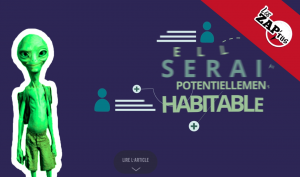 Click on the picture to get a video taste of Les Zap'TusInventing the new local news in France
Click on the picture to get a video taste of Les Zap'TusInventing the new local news in France
As part of News Engagement Day actions, journalism and technology students in did an intense, two-day " #Hackanews" in France. The winning team produced "Les Zap’tus," a visual, multimedia and mobile-based approach to news that provided a “close, live, immersive experience,” according to organizer Etienne Millien, general manager of the youth engagement organization for the regional press, ARPEJ. Sample stories covered surfers and surfing and potentially habitable planets. Millien is a journalist and also head of Sud-Ouest's local crowd-funding platform, SoKenGo. Sud-Ouest hosted the event in its start-up lab and plans to explore development of the concept.
Easier access to all the country's news in the Netherlands and Denmark
School students in the Netherlands will be able to access hundreds of news stories for free via the aggregator “Blendle” in a deal with Niewus in de Klas, the news in education arm of NDP Niewusmedia. A Dutch start-up, Blendle includes national and most of the local and regional press of the Netherlands,  as well as Flemish, German and English-language titles, such as FT Weekend, Huffington Post and the Wall Street Journal. Starting in January, teachers will be able get free access for themselves and their students twice a year for any title. Access to each title will expire after a month’s time. A single user account lets teachers can search by keyword and set up email alerts. Founded in 2014, Blendle is based on pay-per-article business model and is offering the service for free.
as well as Flemish, German and English-language titles, such as FT Weekend, Huffington Post and the Wall Street Journal. Starting in January, teachers will be able get free access for themselves and their students twice a year for any title. Access to each title will expire after a month’s time. A single user account lets teachers can search by keyword and set up email alerts. Founded in 2014, Blendle is based on pay-per-article business model and is offering the service for free.
Denmark’s schools now have access to Avisportalen during a four-week period each school year. Originally designed for the Danish parliament by the media intelligence provider, Infomedia, the portal encompasses 40 titles and allows epaper optimization for tablets, and a keyword search. As a result, students can compare news coverage across several different media titles. “Competitive titles have no problem being featured on the same platform; however, the largest 3 newspapers in the country, are not participating, simply because they provide their own solution,” says Aslak Gottlieb of Danske Medier.
Studying German millennials
Germany's national publishers association, BDZV has completed three phases of an extensive new study of German millennials. Researchers from the University of Bremen (Dr. Leif Kramp) and the Hamburg Media School (Prof. Dr. Stephan Weichert ) in Germany have quizzed 38 editors and 12 major social media practitioners and scoured recent research for insights. Next will come interviews with focus groups of millennials (the generation born between 1981 and 2000, essentially teenagers through younger parents)
Preliminary theses for German millennials generally reflect traits also found in other countries:
- Media consumption is continuous and excessive in comparison to earlier generations, and it is mobile only instead of mobile first.
- Digital and social life are intertwined, which means that the participation in digital activities is equivalent to participation in social activities. The downside? Being constantly online creates a new kind of social pressure, of which this group is very much aware.
- Social media are increasingly pushing traditional online media sources aside.
- ChatApps are emerging as a major force. These include messaging services like Facebook messenger, WhatsApp and Viber, and apps with automatic conversational user interfaces such as Purple & Quartz. Among adolescents, WhatsApp is most popular, while Facebook and Twitter – the platforms their parents use – have become far less attractive to them.
- Millennials reflect on their media consumption and are quite self-critical. However, they also have a critical view of journalists.
The next phases, are in progress: focus groups with millennials in three cities and a search for international trends.
Latest ways to help students do news in Denmark and Norway
Nationwide actions in both countries are adding new twists to the very powerful experience for students of creating journalism themselves on a sleek platform.
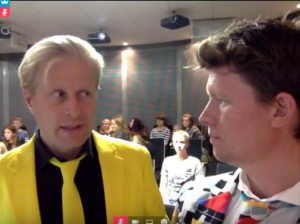 All 2,200 schools in Denmark can now tune into YouTube live webinars and explore the world of news production. Hosted at a local daily newspaper, the webinar allows classes of entire students to join in live, ask the hosts questions, and complete multiple choice assignments during the course. Feedback from teachers around the country shows that they widely and highly appreciate the live format, says Aslak Gottlieb of the Danish media association. "it is simply a very effective way of reaching a large audience," he said. The association discontinued seminars targeting teachers only, “because we have found out that students learn much faster than their teachers,” says Gottlieb. Since the beginning of the current school year this fall, three webinars with a total of 2,000 participating students have taken place so far.
All 2,200 schools in Denmark can now tune into YouTube live webinars and explore the world of news production. Hosted at a local daily newspaper, the webinar allows classes of entire students to join in live, ask the hosts questions, and complete multiple choice assignments during the course. Feedback from teachers around the country shows that they widely and highly appreciate the live format, says Aslak Gottlieb of the Danish media association. "it is simply a very effective way of reaching a large audience," he said. The association discontinued seminars targeting teachers only, “because we have found out that students learn much faster than their teachers,” says Gottlieb. Since the beginning of the current school year this fall, three webinars with a total of 2,000 participating students have taken place so far.
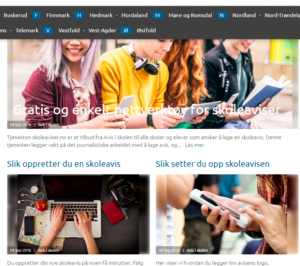 A new, free of charge web tool for creating digital news content in has been piloted in schools throughout Norway and will be available soon for use nationwide. The platform skoleaviser.no which will be offered to schools per license agreement, enables students to post content from Facebook or switch between Facebook and the platform. It also allows direct article feed from the school newspapers to local newspapers’ websites. ““The need for young readers and young voices are growing and it means that several Norwegian publishers are increasingly more open for young voices than they used to be,” says Veslemoy Rysstad of Norway’s media association. “This new tool allows journalists to see if they want to share certain articles from school newspapers on their website. It is meant to jumpstart the dialogue,” she adds.
A new, free of charge web tool for creating digital news content in has been piloted in schools throughout Norway and will be available soon for use nationwide. The platform skoleaviser.no which will be offered to schools per license agreement, enables students to post content from Facebook or switch between Facebook and the platform. It also allows direct article feed from the school newspapers to local newspapers’ websites. ““The need for young readers and young voices are growing and it means that several Norwegian publishers are increasingly more open for young voices than they used to be,” says Veslemoy Rysstad of Norway’s media association. “This new tool allows journalists to see if they want to share certain articles from school newspapers on their website. It is meant to jumpstart the dialogue,” she adds.
Zeitung in der Schule honored for excellence
The host of the briefing, Zeitung in der Schule (ZiS) of Austria, received designation as a WAN-IFRA Center of Youth Engagement Excellence just before the briefing during the WAN-IFRA World News Publishing Expo. The ‘Center of Youth Engagement Excellence’ designation honors initiatives that have a deep, long-term commitment and devote resources to news literacy and youth engagement.
Founded by the Austrian Newspaper Association (VÖZ), ZiS was honored for its innovative and strong News in Education programs that have reached more than 1 million students in the past decade.
Gerald Grünbergeer, Nadja Vaskovich and WAN-IFRA CEO Vincent Peyregne during induction at WAN-IFRA Expo.
Zeitung in der Schule, ZiS has been running since 1995 and in 2016 alone has involved more than 100.000 students.
Nadja Vaskovich, CEO of ZiS noted that “although Austria is among the richest countries in the world, one in five Austrian teenagers cannot properly understand, use and reflect on written texts according to the latest OECD PISA results, Therefore, ZiS’s efforts are more important than ever – concerning not only the faith of the newspaper industry, but the future of the country.”
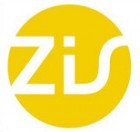 Gerald Grünberger, CEO of VÖZ, concurred, pointing out that “ZiS is Austria’s largest private initiative enhancing media and reading literacy of children and young people on a national level. The programme is supported by almost all of the country’s print media and promotes our democracy.”
Gerald Grünberger, CEO of VÖZ, concurred, pointing out that “ZiS is Austria’s largest private initiative enhancing media and reading literacy of children and young people on a national level. The programme is supported by almost all of the country’s print media and promotes our democracy.”
ZiS has developed a variety of different projects. For example, all Austrian schools are encouraged to participate in ZiS’s Newspaper Project and to order free newspapers for four weeks. Hence, the Austrian newspaper publishers reach about ten percent of all the Austrian pupils throughout all grades and all kinds of schools. ZiS also offers trainings for teachers and student teachers on how to use newspapers and journals in class in the context of media literacy. Journalists give them insights on how newspapers work – from September to June 2016 ZiS trained nearly 500 teachers and students. Next steps involve work in digital news literacy.
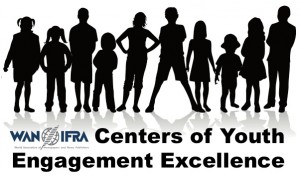 Austria’s ZiS is the 16th initiative to be designated a Center of Youth Engagement Excellence. The others include: the Newspaper Association of America’s American Press Institute, Asociación Nacional de la Prensa (ADP) in Chile, Danske Medier in Denmark, the Finnish Newspapers Association, the Hungarian Publishers Association, the Serikat Penerbit Suratkabar Pusat (SPS) in Indonesia, Mediebedriftenes Landsforening in Norway, NDP Nieuwsmedia in the Netherlands, SPQR, SPQN and ARPEJ in France, Associacão Nacional de Jornais in Brazil, Bundesverband Deutscher Zeitungsverleger in Germany, Nihon Shinbun Kyokai in Japan, Andiarios in Colombia, Les Journaux Francophone Belges, and the Korean Association of Newspapers. Details about all the centers can be found at www.wan-ifra.org/node/44087
Austria’s ZiS is the 16th initiative to be designated a Center of Youth Engagement Excellence. The others include: the Newspaper Association of America’s American Press Institute, Asociación Nacional de la Prensa (ADP) in Chile, Danske Medier in Denmark, the Finnish Newspapers Association, the Hungarian Publishers Association, the Serikat Penerbit Suratkabar Pusat (SPS) in Indonesia, Mediebedriftenes Landsforening in Norway, NDP Nieuwsmedia in the Netherlands, SPQR, SPQN and ARPEJ in France, Associacão Nacional de Jornais in Brazil, Bundesverband Deutscher Zeitungsverleger in Germany, Nihon Shinbun Kyokai in Japan, Andiarios in Colombia, Les Journaux Francophone Belges, and the Korean Association of Newspapers. Details about all the centers can be found at www.wan-ifra.org/node/44087


